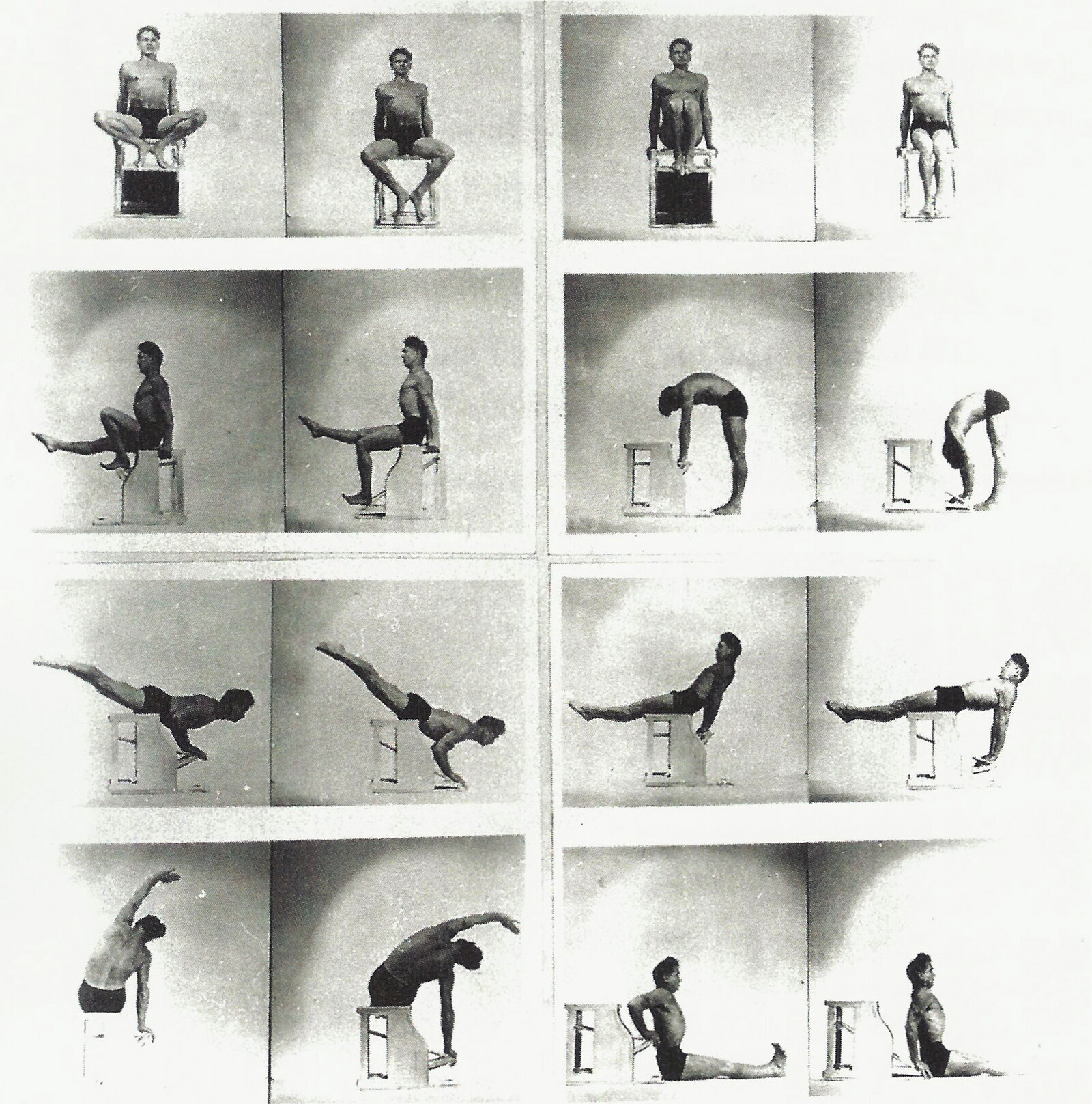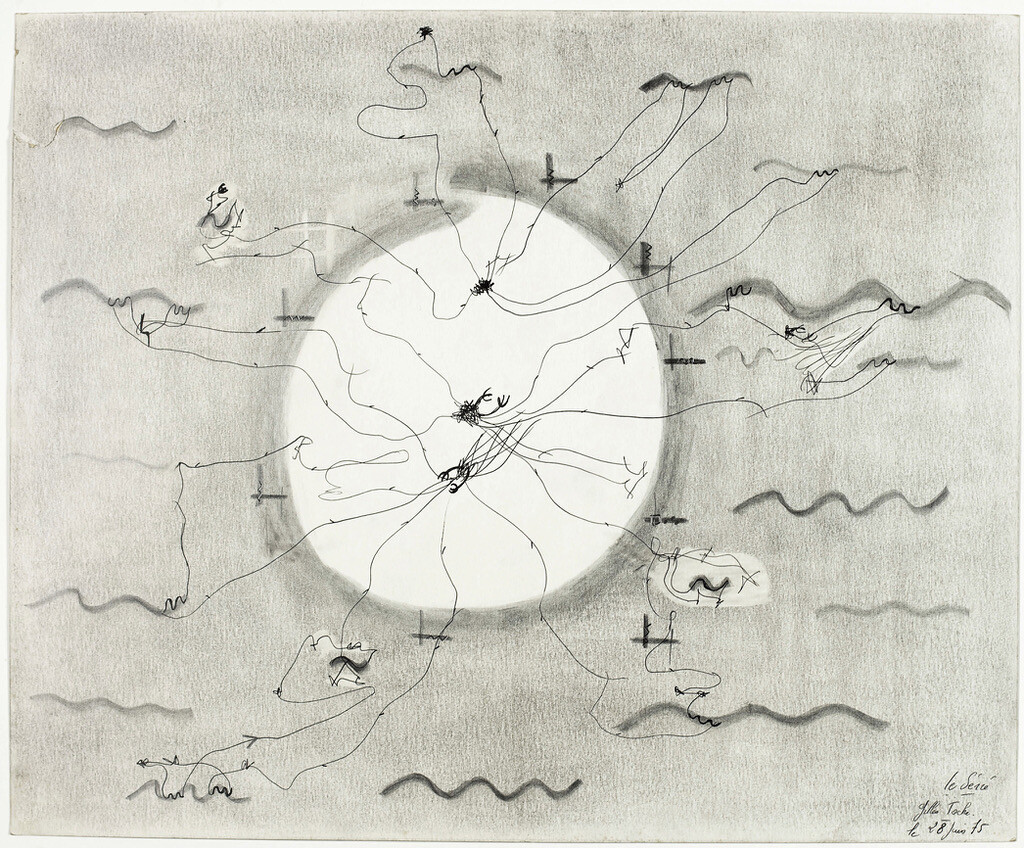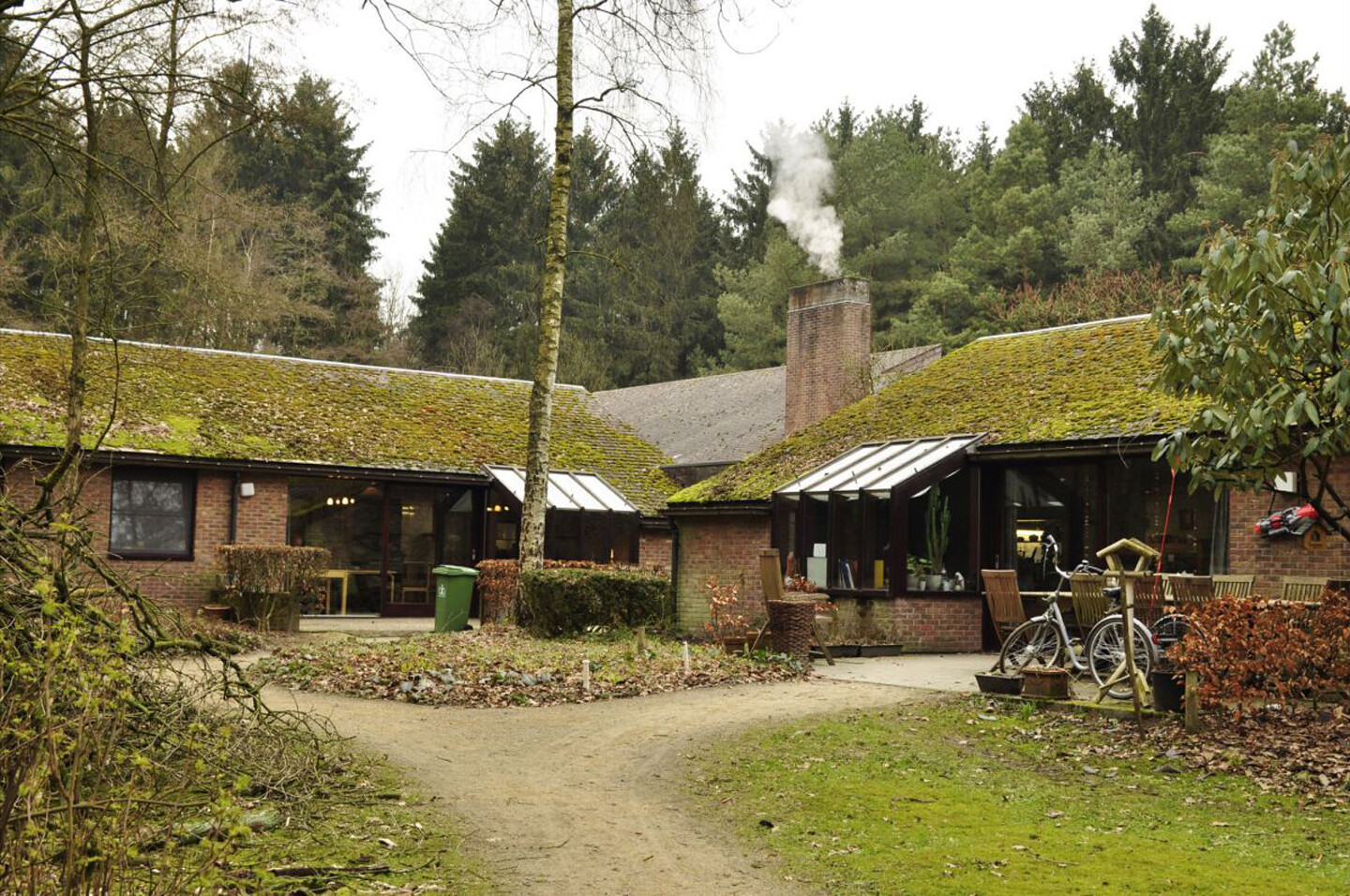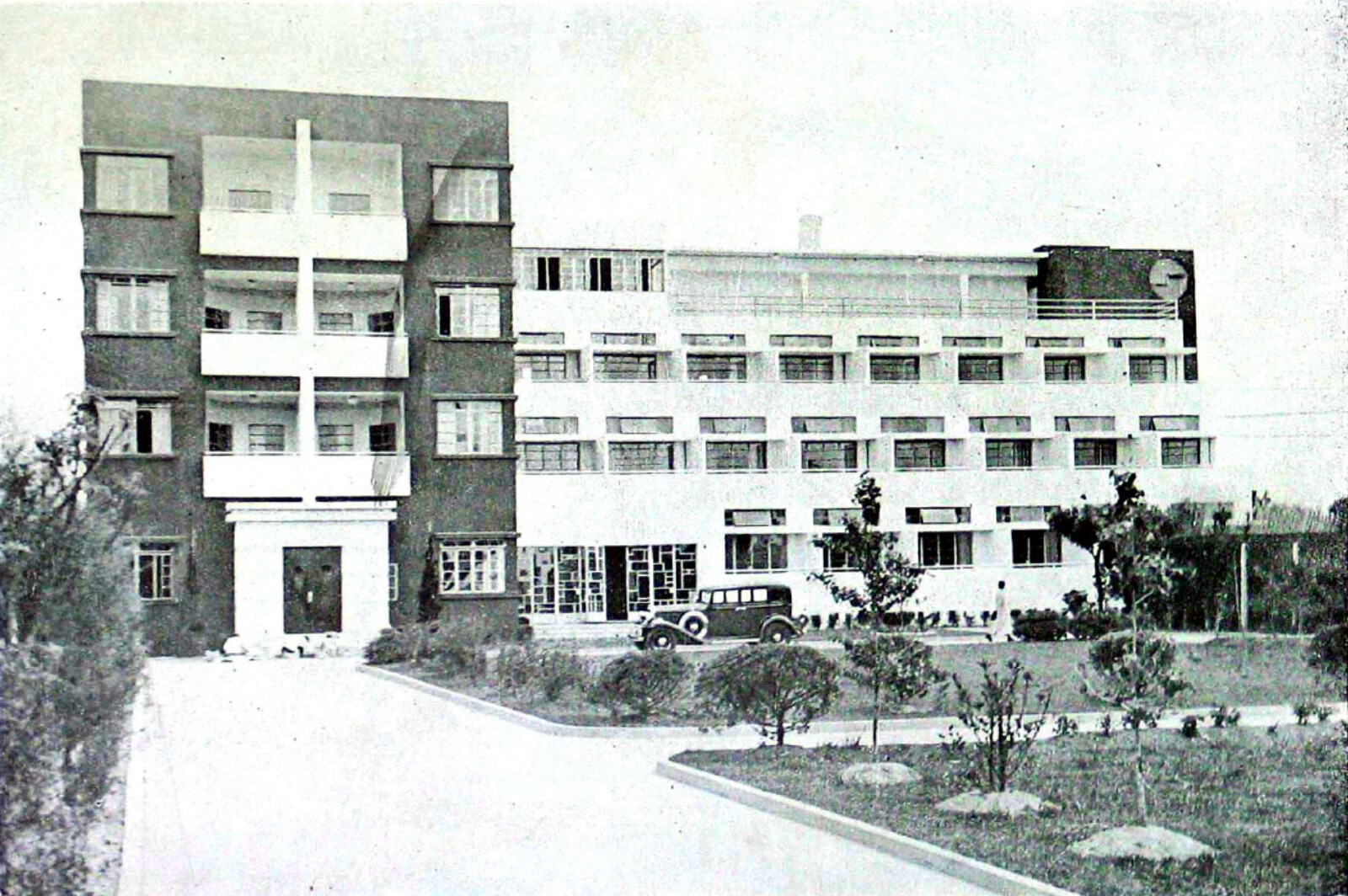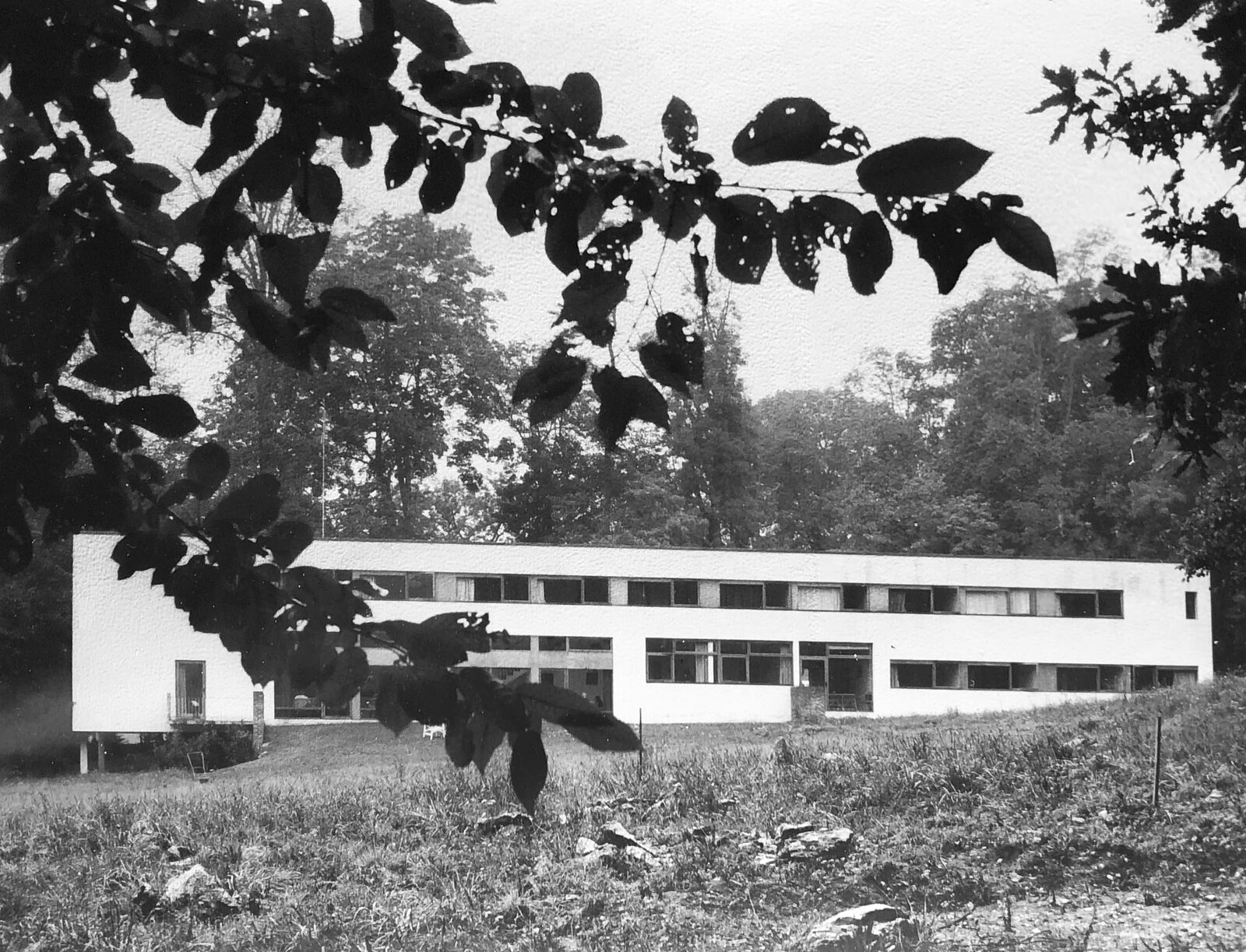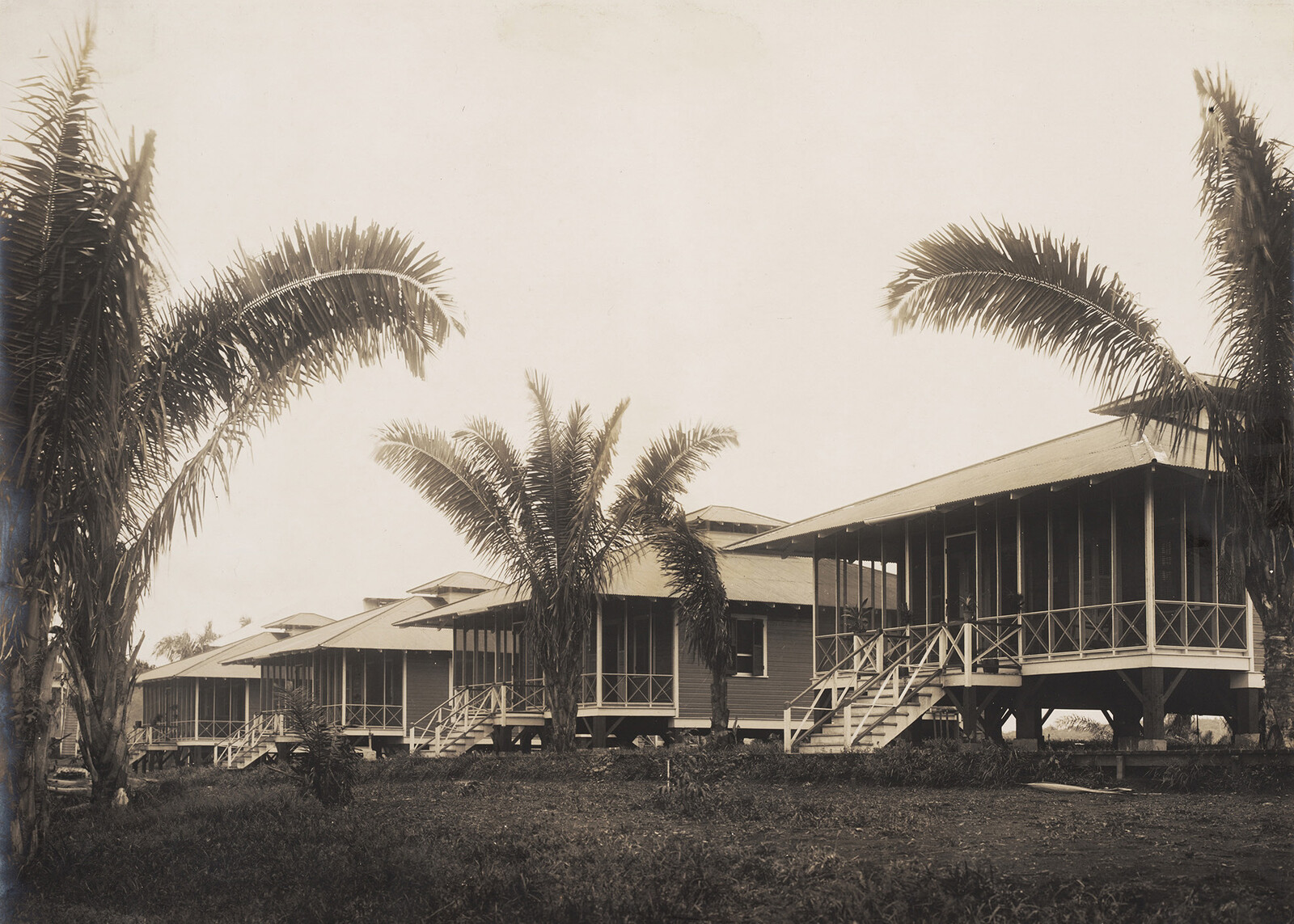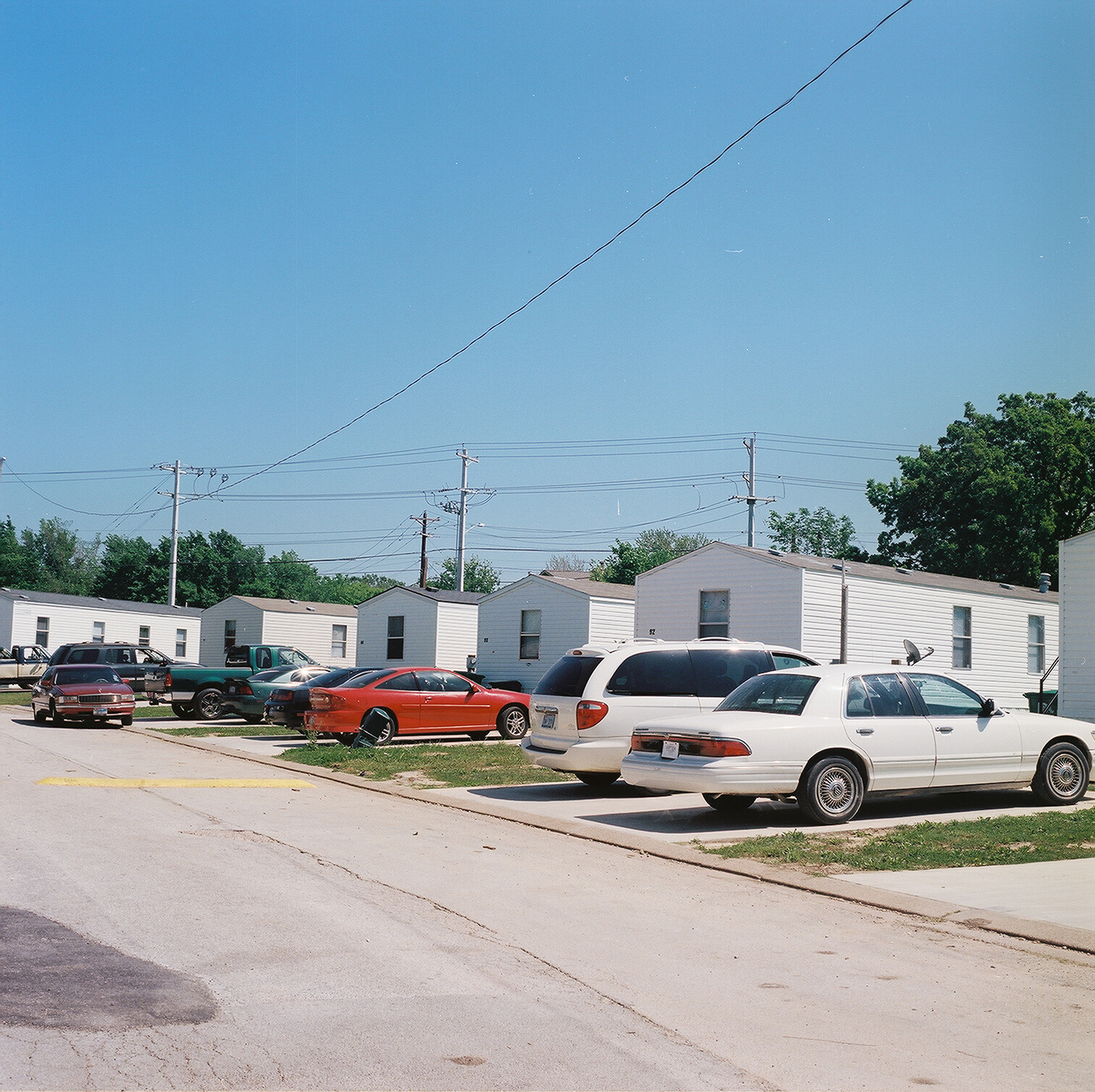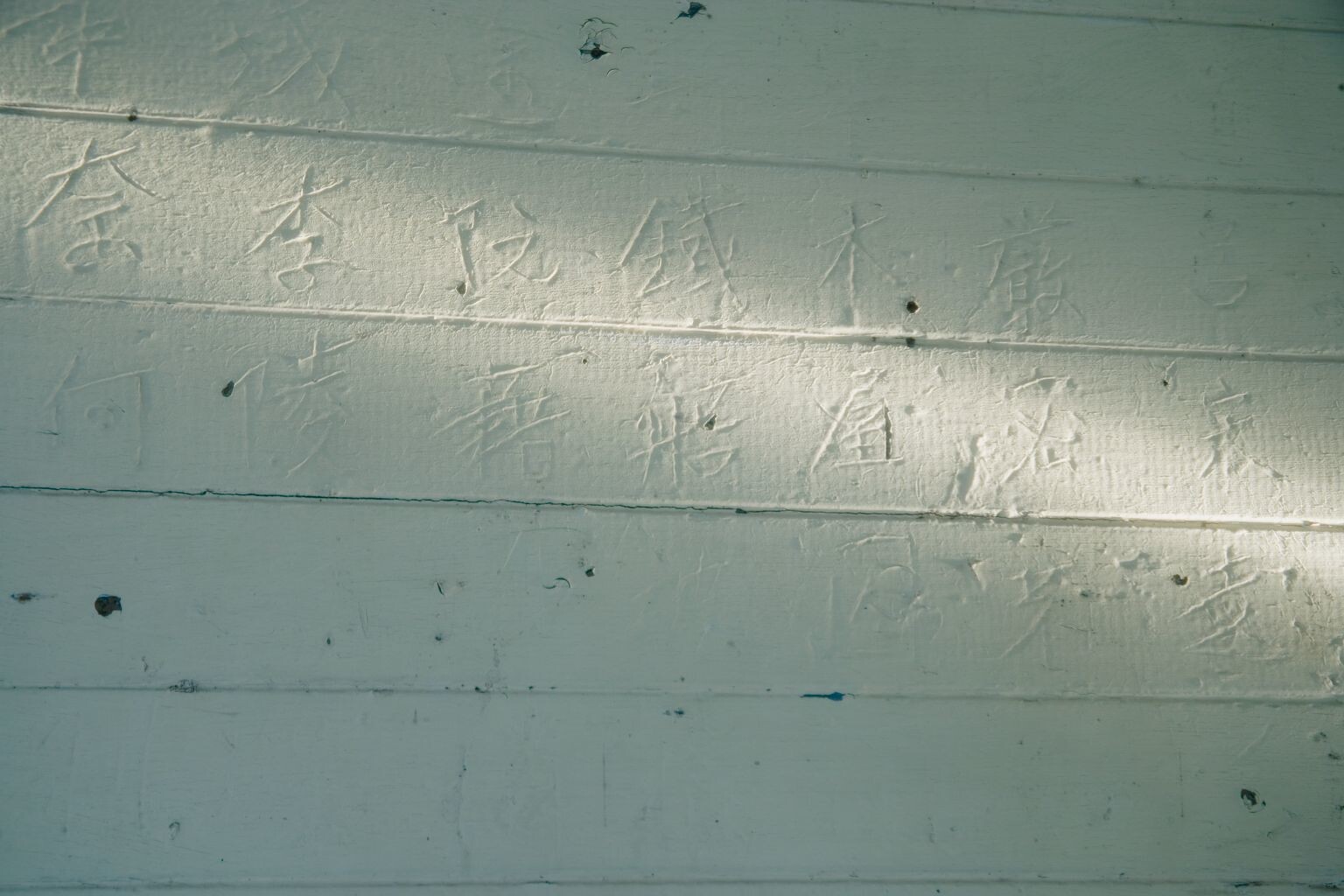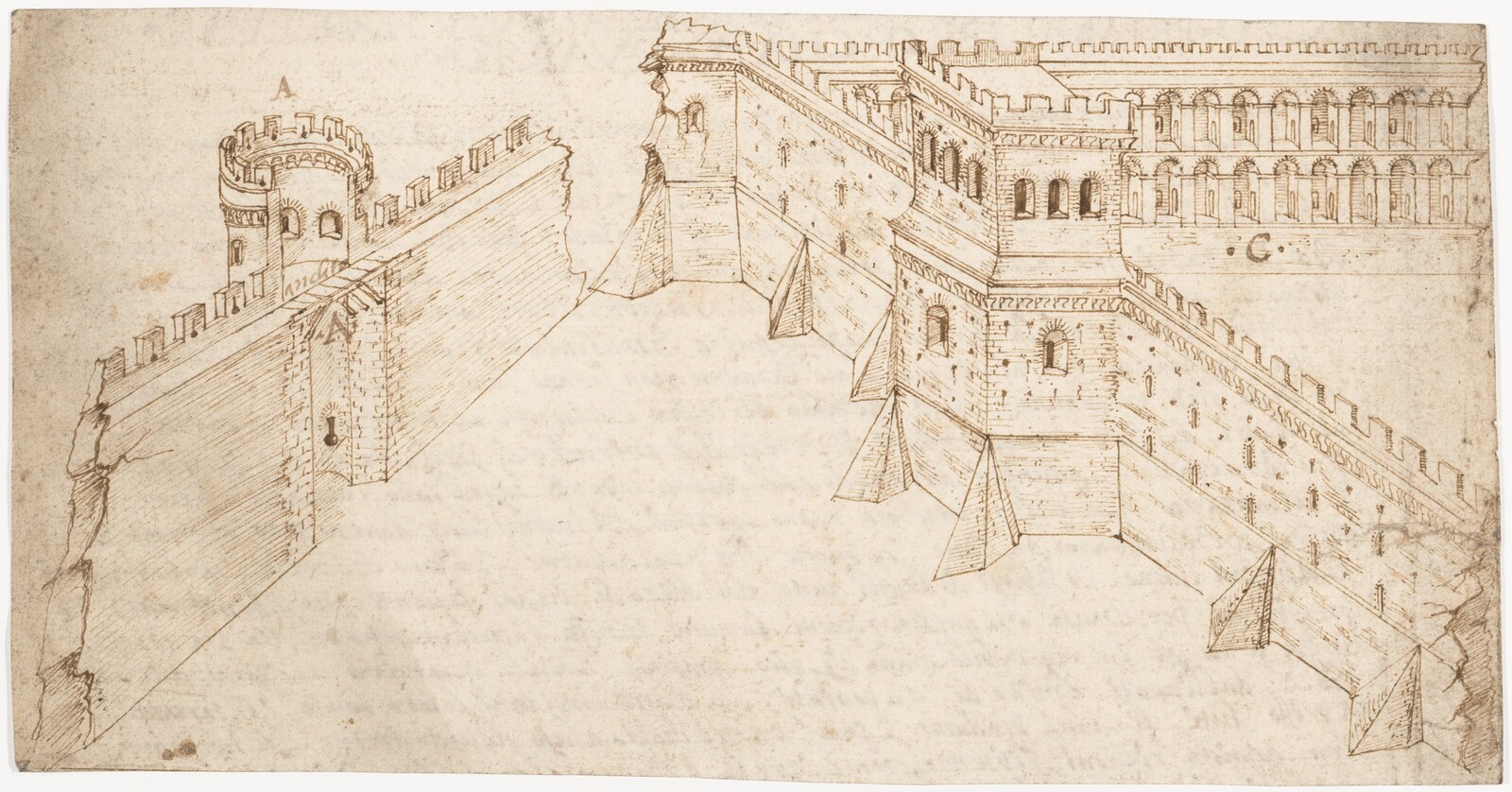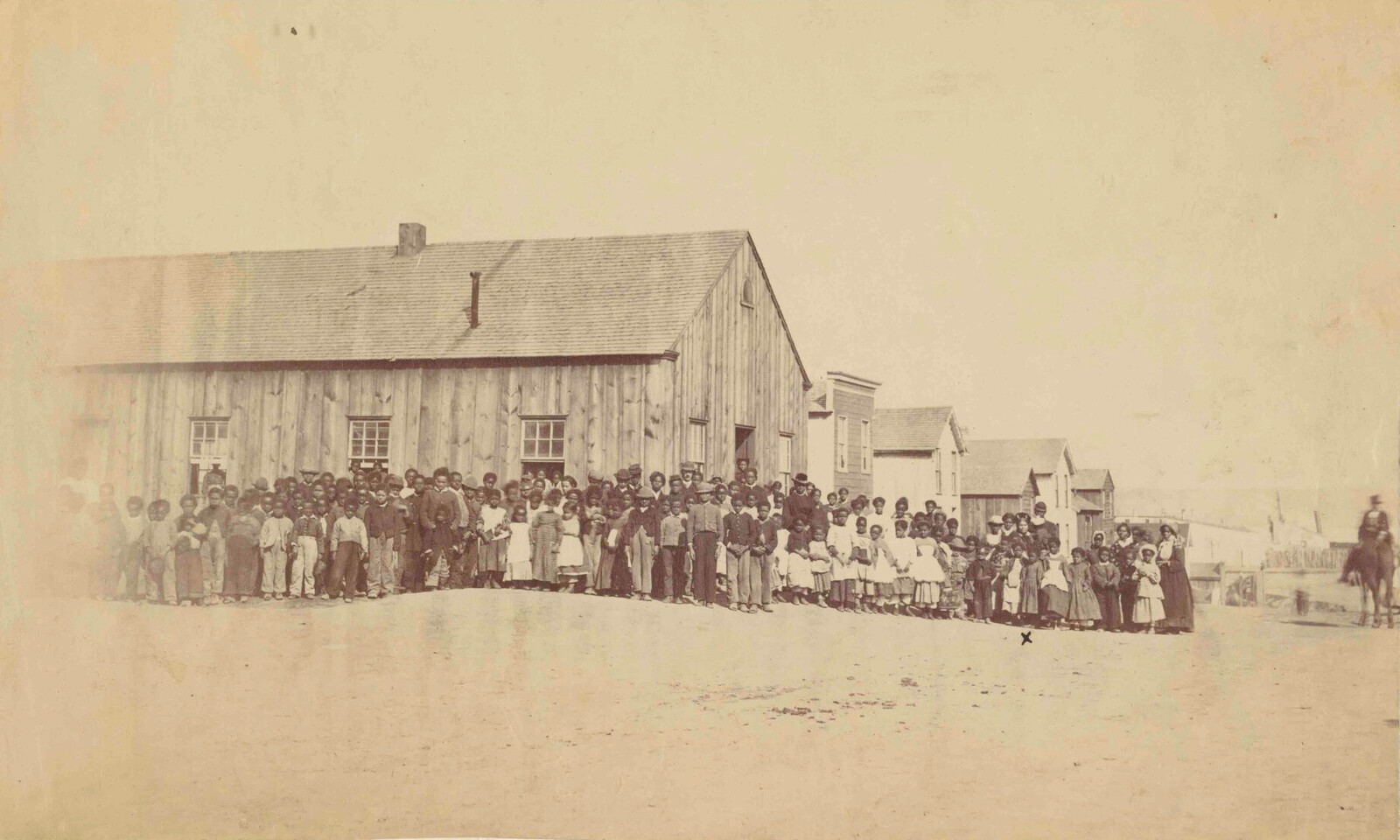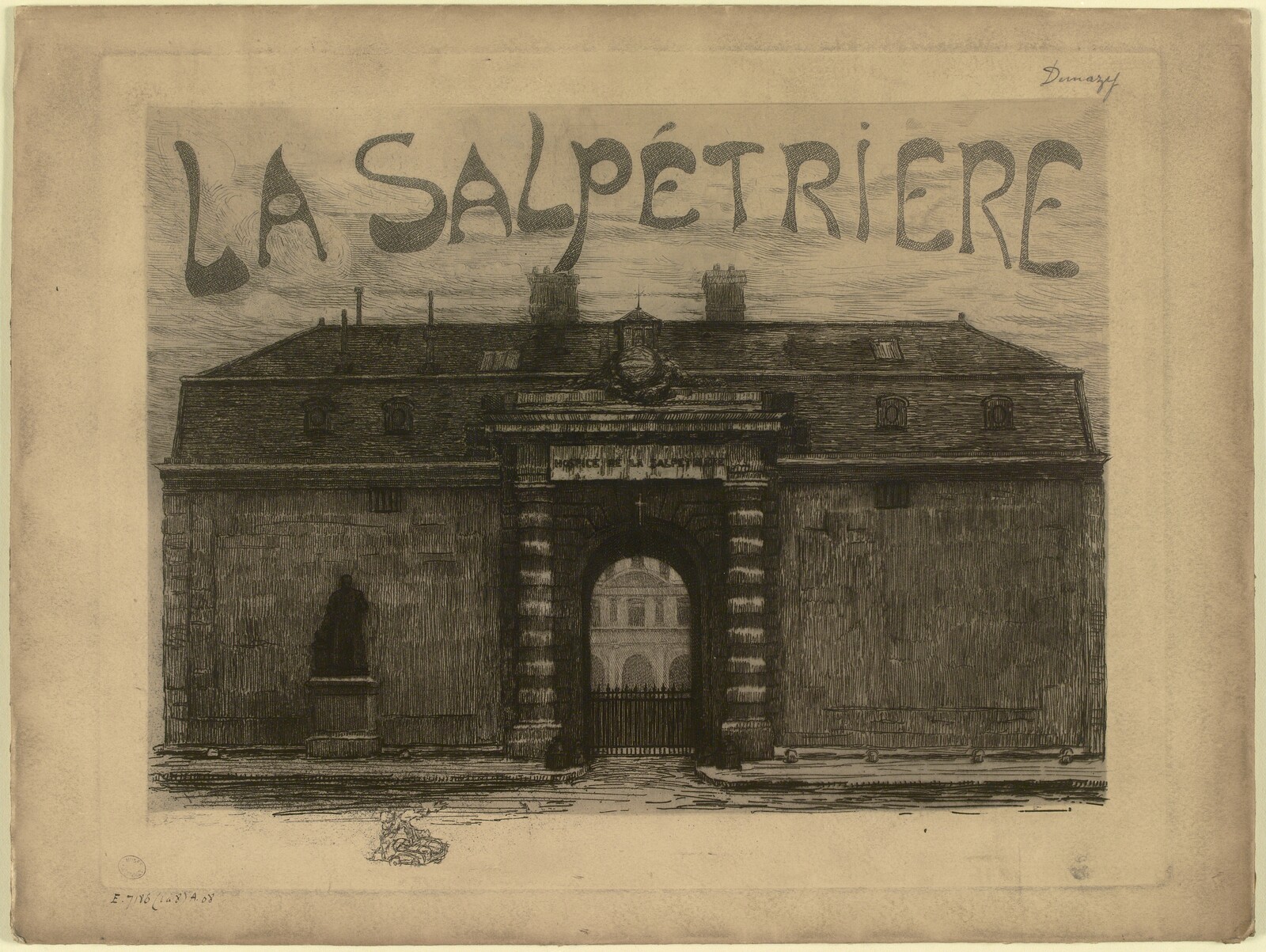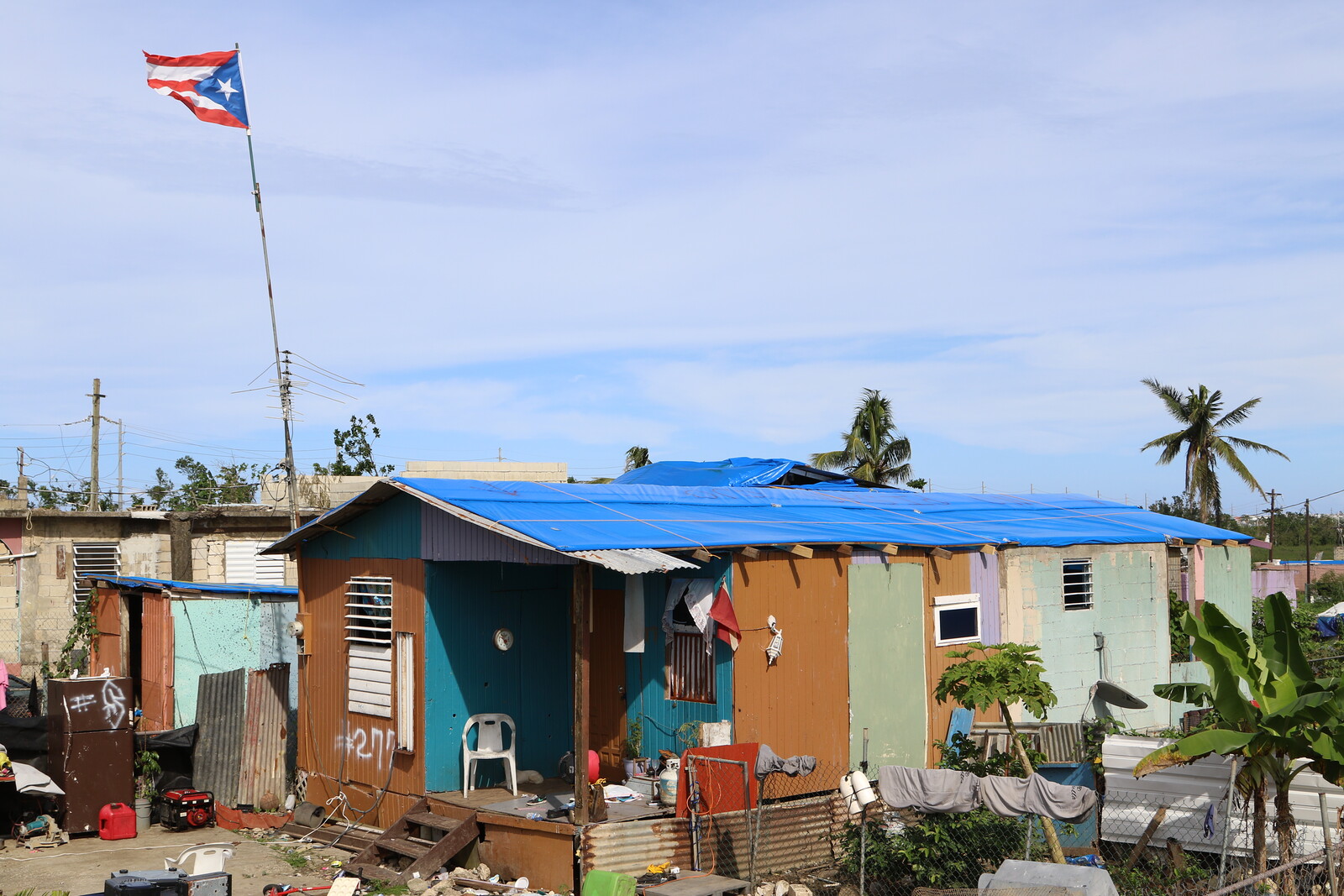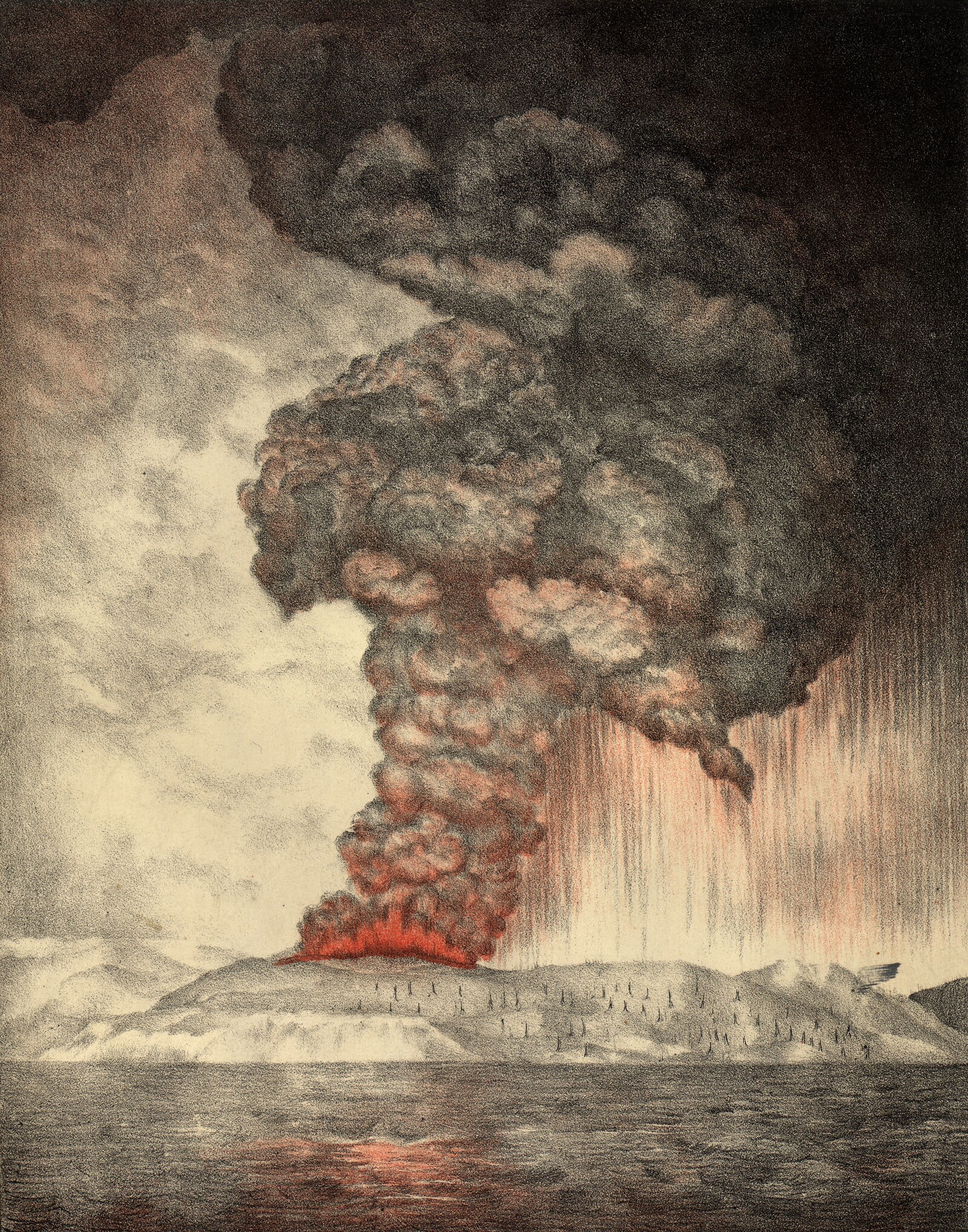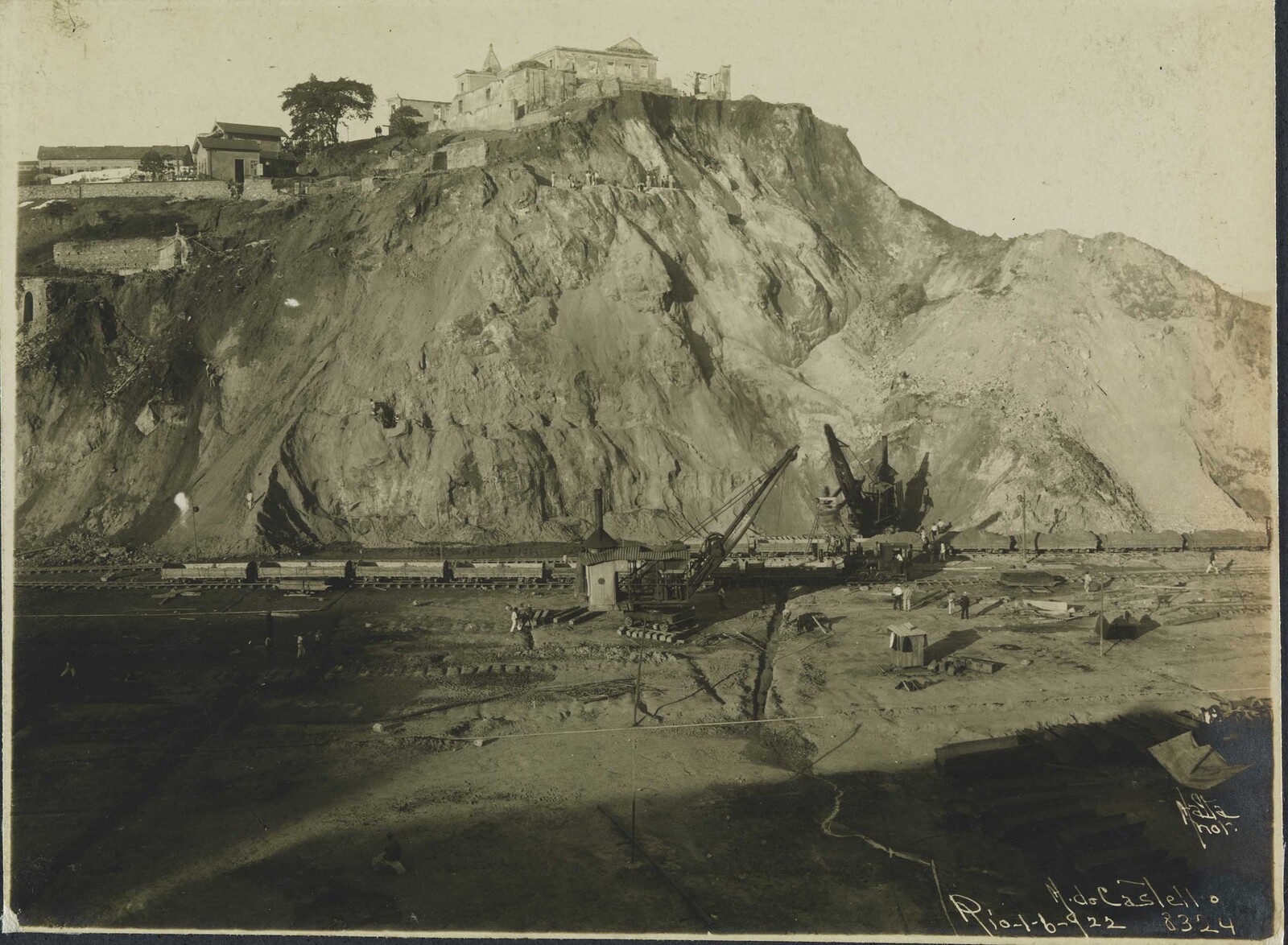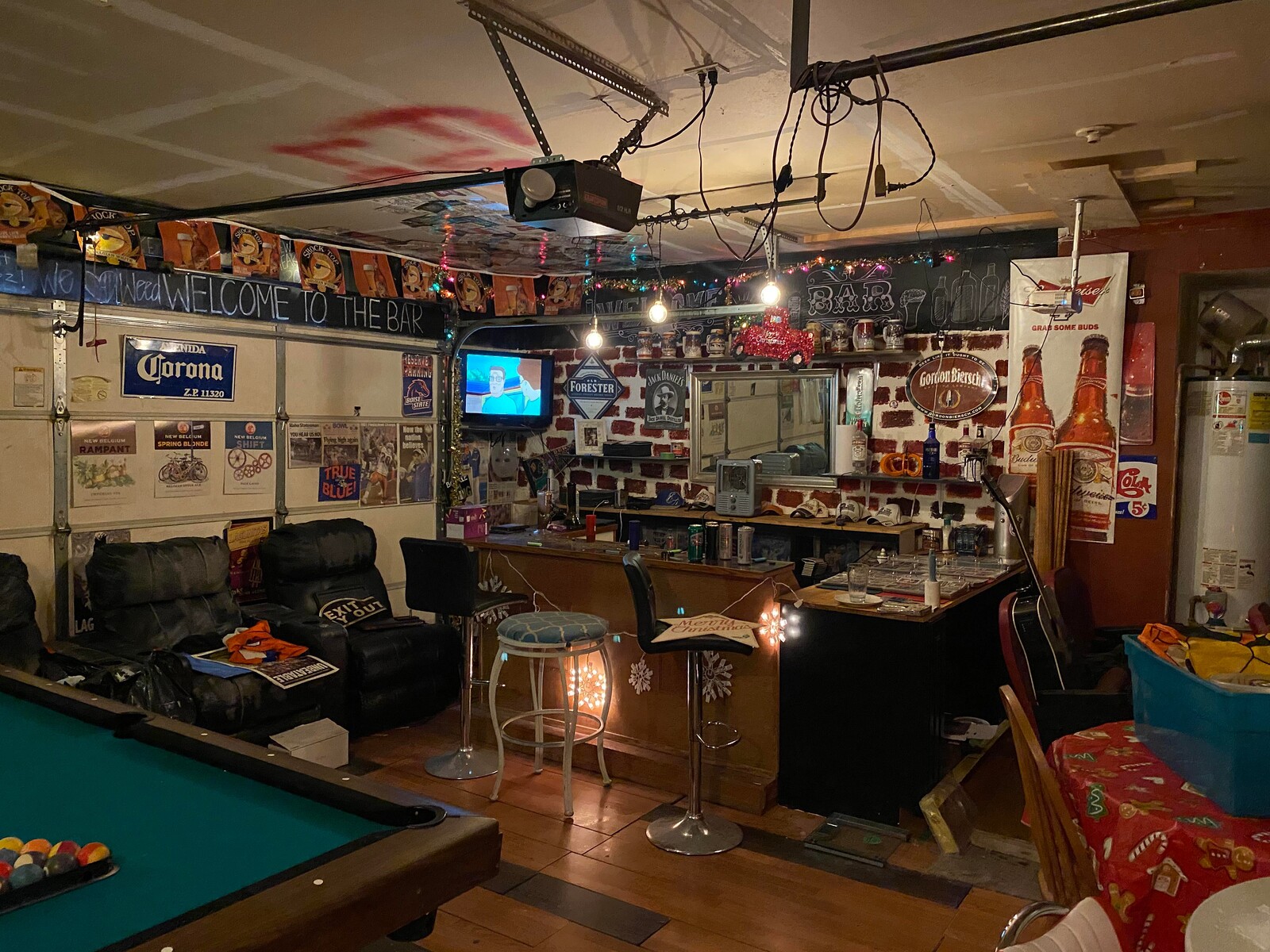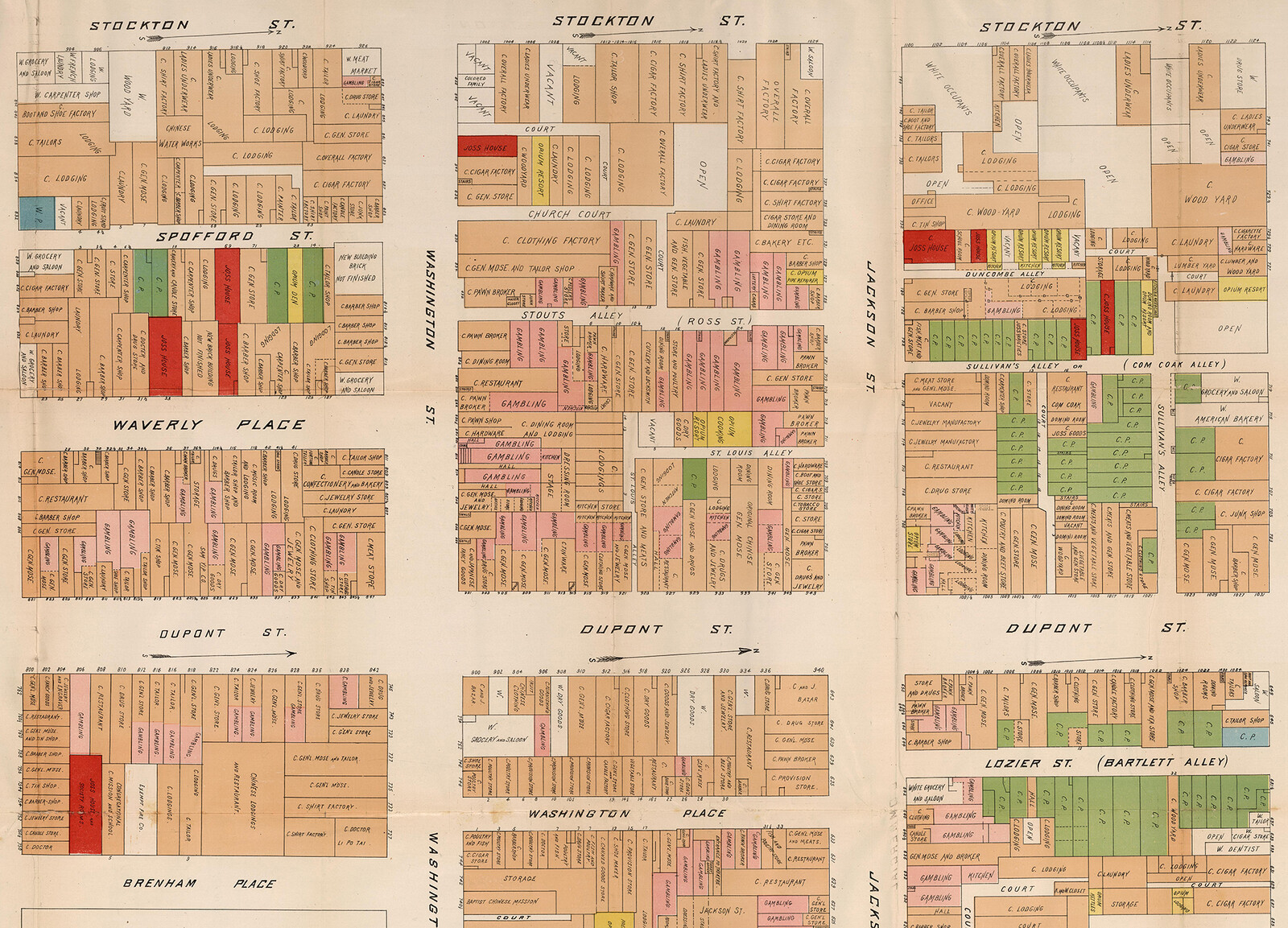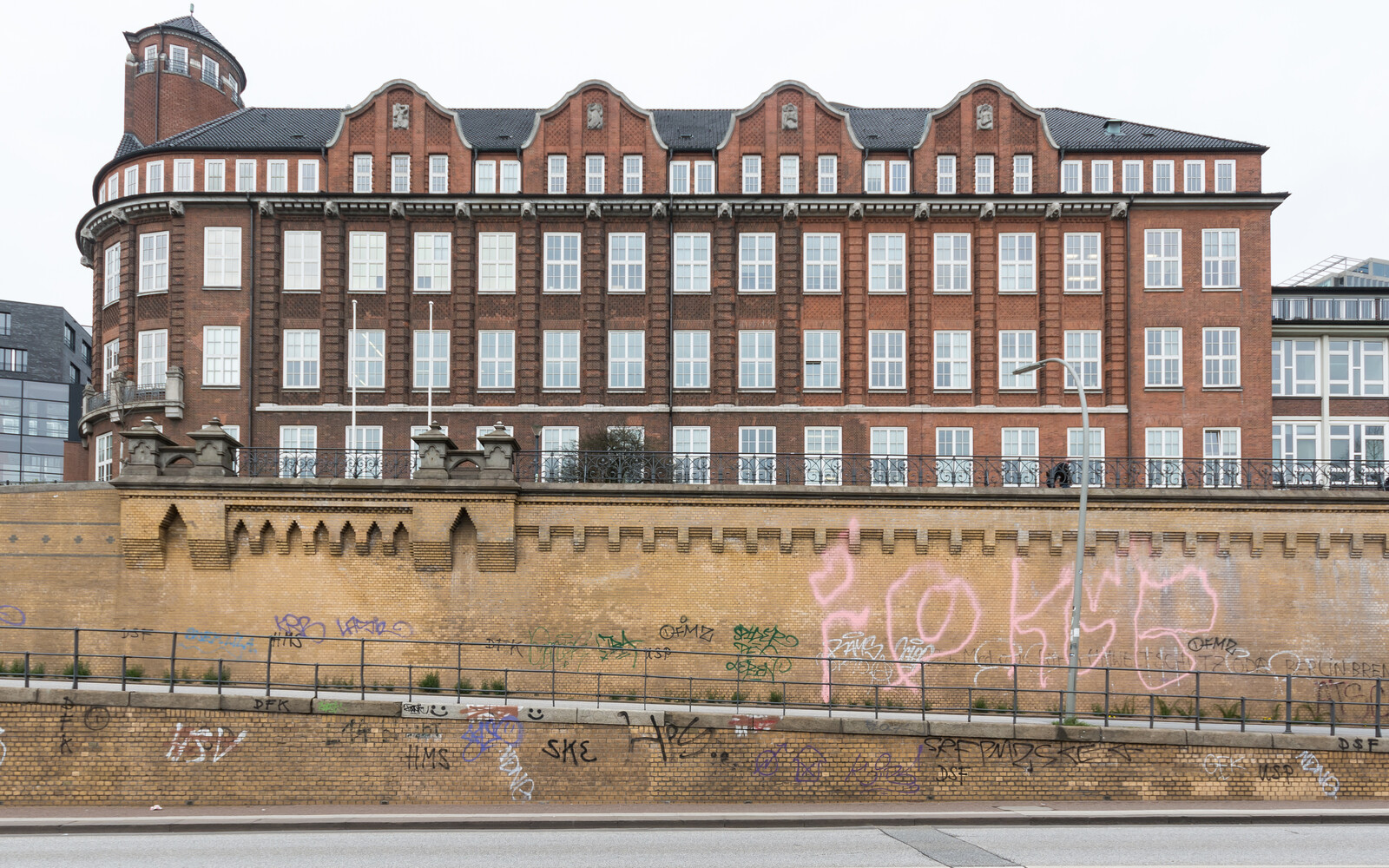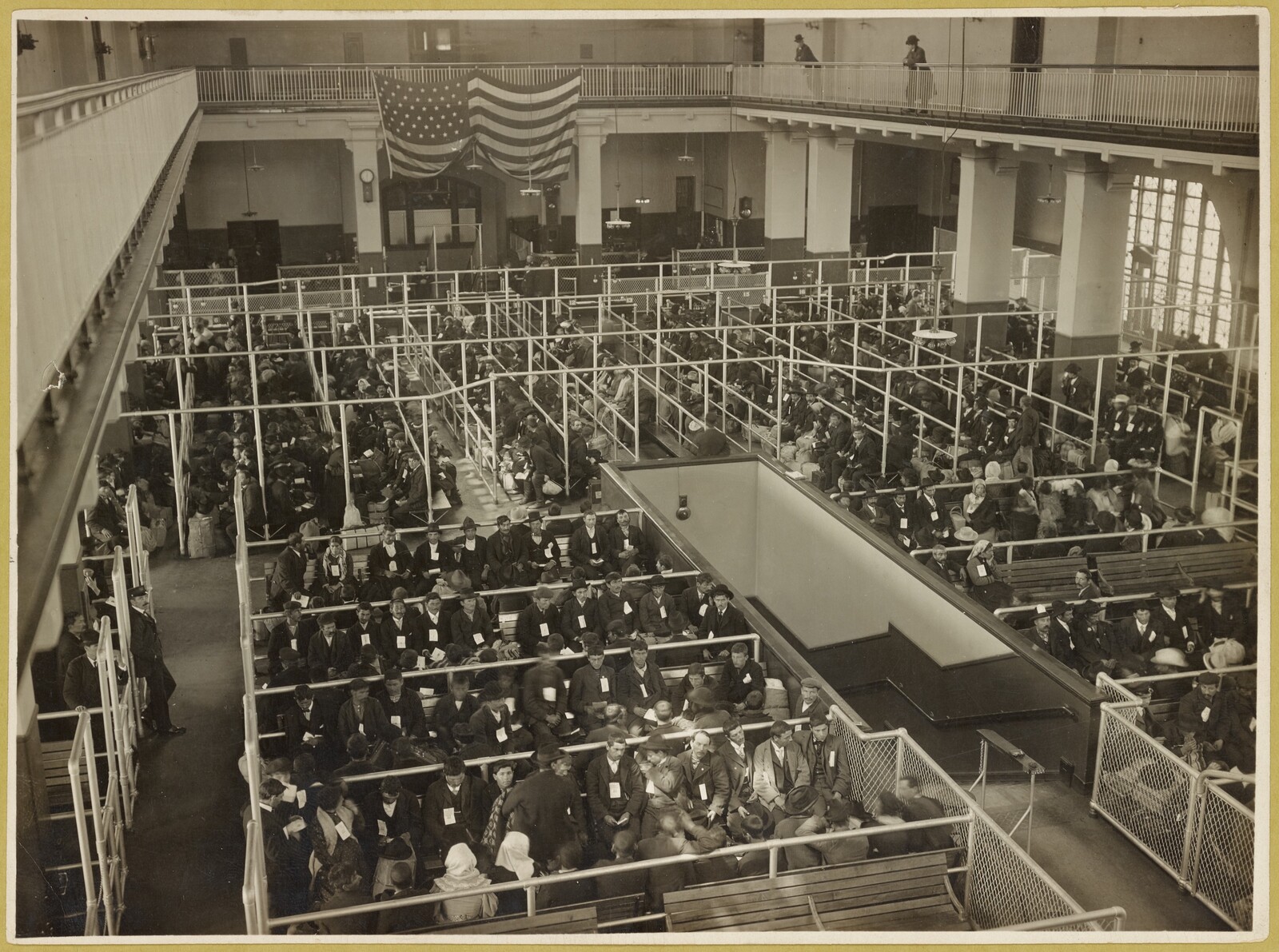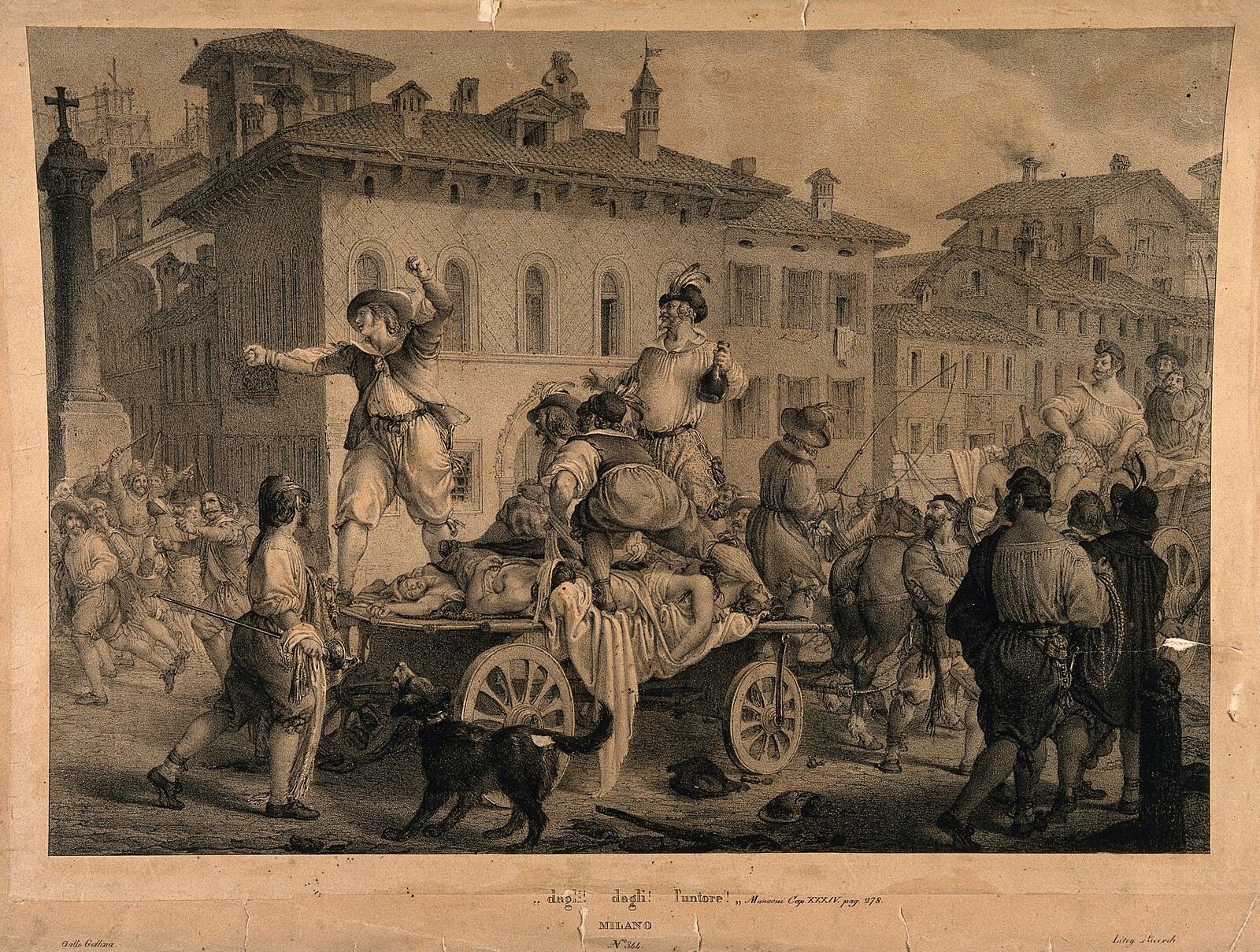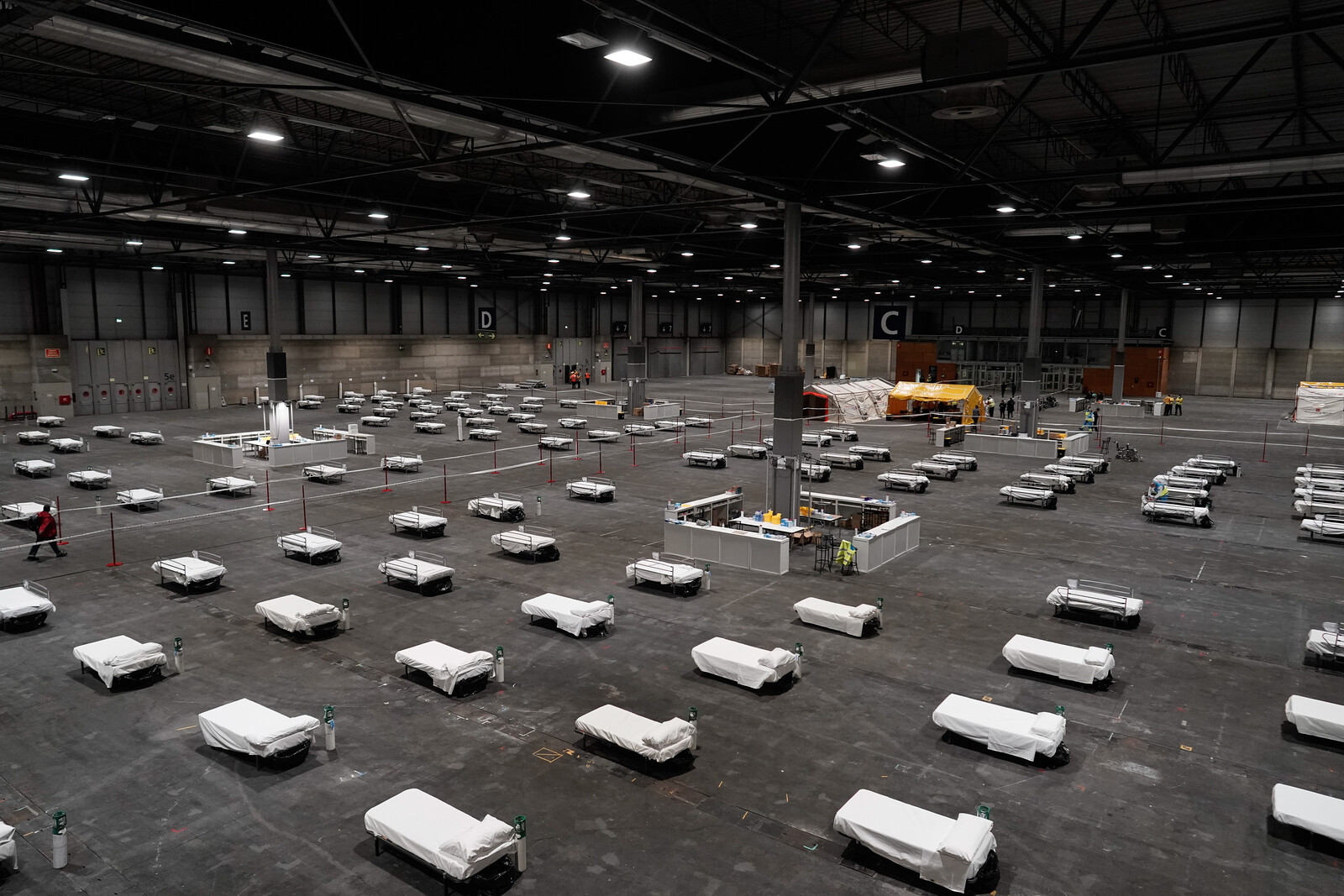Arrested in motion, Earth appears precariously imbalanced. Crowned with a turreted city model, the personification’s muscular body twists auspiciously into the foreground. Intent on stability, their left arm forcefully presses downwards, hand firmly grasping an oblong stone. The right holds out a needle-like scepter, threatening to answer any agitation in the surroundings by piercing the carnal fabric below. Overcast sky tinges the scene with a hostile atmosphere. In the background, a city emerges hewn out of the mountainous ridge to the left. On the right, naked cave dwellers depart their lithic darkness by terraforming, extracting resources. Their tool mirrors the directionality of Earth’s scepter as it breaks into the soil. Earth appears apathetic yet tense. The allegorical “Terra” forcefully illustrates the foreboding entanglement of culture and nature in Western conceptions of the Earth. As the ultimate mediator between natural and artificial environments, architecture crowns Earth as the paradigmatic synthesis of anthropic agency and simultaneously serves as its emblematic caution.
Concerns of human and planetary health have always been closely entangled, growing increasingly closer at a moment when public discussions shift focus to lament the Earth’s transformation from a biosphere (a sphere of life) to a thanatosphere (a sphere of death). Yet, instead of evolving towards equilibrium—as entangled objects do according to current physical theories of thermodynamics and quantum mechanics—their relationship has unraveled into sustained disequilibrium. Planetary infirmity is materialized through significant climatic shifts, excessive anthropogenic vibrations, the resultant corruption of its biospheric system, as well as the redistribution of its mass and axis through glacial melting.
Crucial awareness of planetary health has materialized most profoundly in periods when human agents are either temporarily removed from the intricate ecological systems they otherwise dominate or attempt to gain superior control over the planet through technoscientific innovation. Viral pathologies and their preventative measures during the height of Covid-19 demonstrate the collective capacity of human societies to counter encroaching human sickness swiftly and effectively. Lacking adequate geopolitical protocols and actionable processes of counter-balance regarding planetary health, however, Terra charges architecture to resume its once crowning role, balancing their heart and body.
Terra Infirma
In a selfish manner befitting the species of homo sapiens sapiens, 2020’s SARS-CoV-2 pandemic bundled humanity’s focus in hitherto unknown intensity on the fragile physiological envelopes that contain its beings and the organic systems that service it. Invisible viral spores transformed human bodies into supernodes of a rupturing ecology of disease, painfully dividing communities as proximity became synonymous with potential contamination. Governmental orders imposed lasting states of emergency instructing citizens to preventatively shelter in place, work from home, or quarantine those exposed. Containment measures introduced to combat the spread of the novel coronavirus emptied streets, schools, offices, and entire districts previously brimming with the bodies of their human dwellers. Moderating the movement of Earth’s population to mitigate the pandemic outbreak, these anti-Covid-19 lockdown protocols led to an unprecedented deceleration of global transport, extraction, and construction industries. Combined, the abatement of human activity across the planetary surface slowed the vibrational agitations of the Earth, its constant microseismic activity, culminating in the greatest seismic quiet period in recorded history.
Whether violent extractive processes that erode the planetary crust in search of mineral resources or footsteps treading their daily paths to downtown buildings, “human activity causes vibrations that propagate into the ground as high-frequency seismic waves,” explained seismologist Thomas Lecocq of the Royal Observatory of Belgium.1 New subdisciplines such as urban seismology have formed to investigate the various origins of earth vibrations within cities, ranging from footquakes (e.g., synchronous footsteps celebrating goals in soccer stadiums) to the seismic impact of architectural construction, fireworks, or subway trains.2 In the first half of 2020, seventy-five researchers from sixty-six associated institutions globally joined Lecocq in an exhaustive analysis of the seismological effects of the global SARS-CoV-2 pandemic, correlating restricted human activity measures with anthropogenic vibratory impulses—hiFSAN, or high frequency seismic ambient noise (4-14 Hz)—that constantly move the Earth.3

Global temporal changes in seismic noise (daily median hiFSAN). From: Thomas Lecocq et al., “Global quieting of high-frequency seismic noise due to COVID-19 pandemic lockdown measures.” Science 10.1126/science.abd2438 (2020).
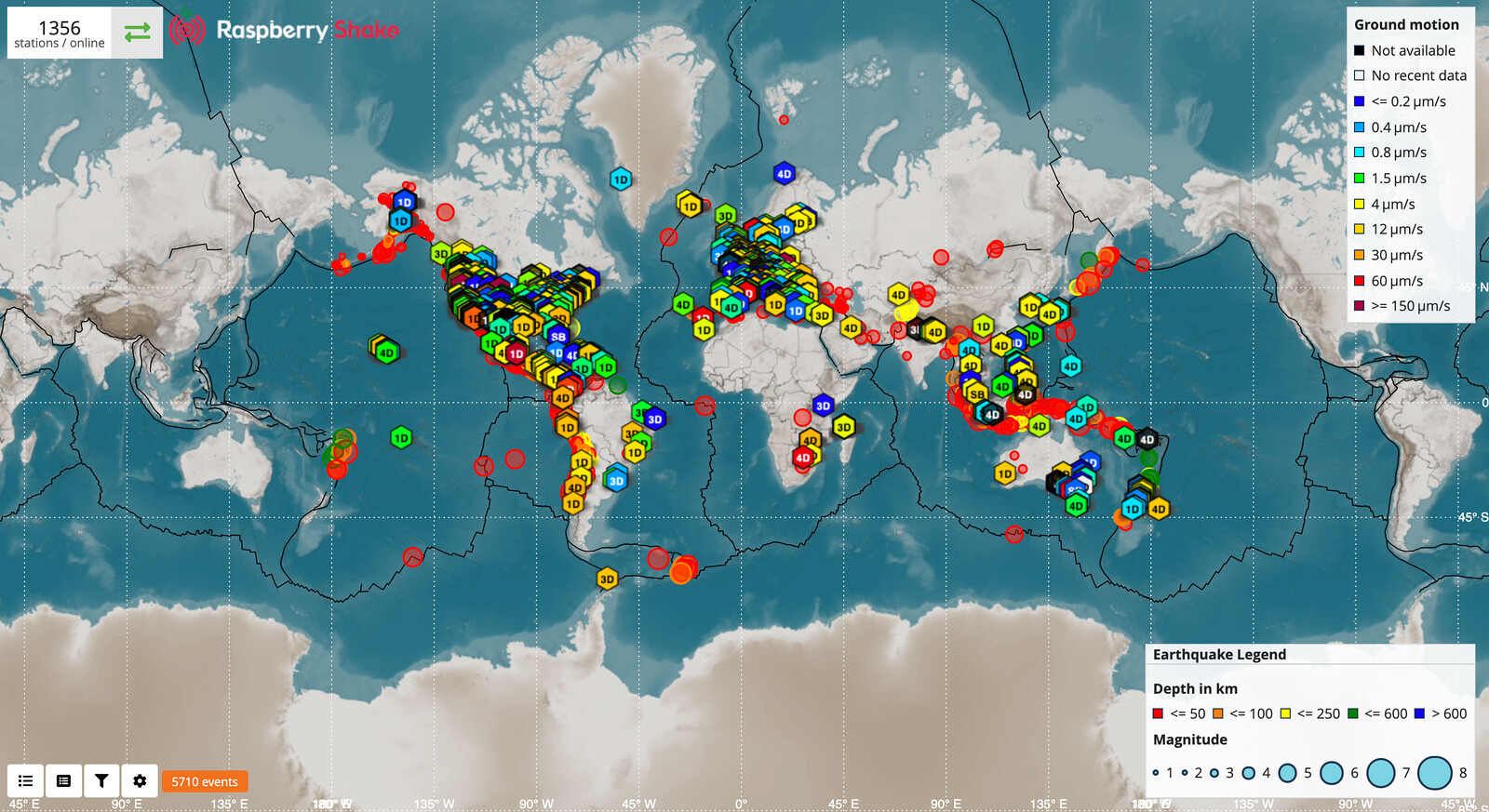
Raspberry ShakeNet, global overview of all (online) stations, September 21, 2021. Screenshot of author’s account. Courtesy Raspberry Shake.
Global temporal changes in seismic noise (daily median hiFSAN). From: Thomas Lecocq et al., “Global quieting of high-frequency seismic noise due to COVID-19 pandemic lockdown measures.” Science 10.1126/science.abd2438 (2020).
Sourcing data from seismic networks located in densely populated urban areas and taking advantage of a wide spectrum of sensors, ranging from broadband seismometer stations to personal seismographs, Lecocq et al. demonstrated that global metropoles such as London, Paris, Brussels, Jakarta, and Los Angeles experienced extraordinary drops, from thirty to fifty percent, in hiFSAN during periods of lockdown. The measurement of planetary ground motion and environmental infrasound activities during this “quiet period” allowed observations of micro-seismic events otherwise masked by the din of human enterprise and provided an unknown epistemic cache.
The liquid habitat of myriad organisms, covering seventy-one percent of the Earth’s surface, was similarly quieted by anti-Covid-19 protocols. Slowing commercial and touristic shipping to a significant degree led to an immediate ecological response in coastal regions all over the globe. Entire families of whales, whose echo-communicational capabilities were relieved from the deafening vibratory drone of human vessels, returned to areas they avoided for decades. On land, various mammals, amphibians, and birds reclaimed the otherwise vibration-rich urban spaces of human dwellers that frequently displace them.4
Displacement is likewise enacted on a different, totalizing planetary scale. A recent study compared space geodetic observations between 1981–2020 to show that geophysical excitations from atmospheric, terrestrial, or hydrospheric zones are coupled with the unfurling climate crisis. Due to global warming, changes in terrestrial water storage systems (e.g., melting glacier mass) are increasingly related to secular polar drift. In other words, water runoff from melting ice leads to the redistribution of Earth’s corporeal weight, which in turn drives an eastward drift of the Earth’s geographical pole, “the point where the Earth’s rotational axis intersects its crust in the Northern Hemisphere.”5 Anthropogenic activity thus not only triggers defining vibratory agitations of the planetary surface, signaling planetary infirmity through disruption of its biospheric system, but shifts the Earth’s axis as its moves through the universe.
From the Heart to the Body of the World
On April 17, 1889, Prussian astronomer Ernst von Rebeur-Paschwitz accidentally recorded seismic waves that originated 9,000 km (5,500 miles) from the Astrophysical Observatory in Potsdam, Prussia, and forty-five minutes before his delicate horizontal pendulum sensed them at 5:21 pm. The vibrations had traveled from Japanese earthquake faults near Tokyo through the Earth’s crust to Potsdam at 3,060 meters per second, providing the first proof of “teleseismic” events: vibrations dissipating while deforming the planetary body that pulses, in the words of seismologist Cargill Knott, “like a beating heart.”6 This event brought about paradigmatic shifts in knowledge about the planet obtained through the physical phenomenon of vibration. What had previously been the ultimate obstruction to precise scientific observation suddenly became geophysics’ defining epistemological tool. This turn was mirrored in architecture, with a shift in focus from insulating against “parasitic” exterior disturbances to isolating the “symbiotic” interior vibratory energies of the planet for study. Paul Emanuel Spieker’s Astrophysical Observatory (built 1876–1879), for instance, only recently innovated the structural design of scientific compounds to provide vibration-free environments.7 Architects and scientists now had to distinguish between parasitic and symbiotic vibrations.
In the final months of his tuberculosis-ridden life, Rebeur-Paschwitz was preoccupied with the conception of “a scheme for the organized study of earthquake-pulsations all over the globe.”8 Cut short in 1895 at the age of thirty-four, his vision of an international, global network of scientific observatories rehearsed well-established fantasies that sought comprehensive knowledge about the Earth and its atmospheric activity.9 However, only recent technological advancements in telecommunication (e.g., electric telegraphy) and mobility (e.g., steamboats, railroads), coupled with the economic and colonial motivation of imperial geopolitics, provided hitherto unprecedented resources to realize the dream of a global system of observatories.
In 1898, Emil Wiechert assumed the world’s first Chair of Geophysics at the Georg-August-Universität in Göttingen, Prussia, and picked up on Rebeur-Paschwitz’s scheme. The geophysicist soon ventured to establish the rural enclave as a global supernode in the exponentially growing network of planetary science centers seeking to deduce the Earth’s interior structure through seismic vibrations. He did so foremost through his advanced seismographs, which could visually amplify seismic vibrations by a factor of up to 1,000 and offer planetary data with unprecedented detail and consistency. Units such as the ultrasensitive 1,000-kilogram Wiechert pendulum could sense vibrational agitation halfway around the globe.
Personal physiological infirmity drove Wiechert’s interest in the vibratory frequency of the Earth. The critical development of instruments that could sense the deepest depths of the Earth, eulogized the archaeologist Hermann Thiersch at the geophysicist’s funeral in 1928, could be linked to the apparatuses that aided Wiechert’s progressive hearing loss.10 Placed on the surface of the planetary body, Wiechert’s automatic seismographs were not unlike electric hearing aids or medical stethoscopes in amplifying and sensing near-imperceptible vibratory signals. Deducing knowledge about Earth’s physical states, geophysicists further entangled the human and planetary body through their respective vibrational production and susceptibility.
Seismic Colonialism’s Modular System Boundaries
In 1903, at the Second International Seismological Conference of the newly founded International Association of Seismology and Physics of the Earth’s Interior (IASPEI) in Strasbourg, Wiechert reflected on the recent establishment of scientific outposts in the German colonies, particularly German-Samoa’s Geophysical “Samoa-Observatory,” the empire’s leading meteorological beacon in the South Pacific. Foregrounding the potential of applied geophysics, he addressed IASPEI’s soaring interest to establish a centrally coordinated and organized network of seismic sensors that could emulate through recording, measuring, and analyzing pulsating planetary vibrations what Wilhelm Röntgen had shown to be possible with the application of his X-rays: namely, to make transparent (to scientific knowledge) solid, opaque bodies.11
In his conference presentation, Wiechert hinged the international motivation for his global scientific endeavor on the idea of Heimatsgefühl, a shared, common sense of Heimat—that distinctly German untranslatable, which encompasses diverse notions of home, nationality, but also original belonging. This feeling, he stressed, transcends any national, social, or racial boundaries, since “just as the individual pays loving attention to the things that surround them in their daily home … so for humanity as a whole, personal interest connects it to the special cosmic body ‘Earth.’”12 With the sober aside “And where love does not guide, material needs force attention,” the geophysicist’s words channeled an uncharacteristically prescient environmentalism that connected the violence of planetary geography with that of human industry as legitimizing strands of colonial expansionism.
“As soon as we penetrate the Earth to extract the minerals necessary for our modern life,” Wiechert stressed, uninformed human operation may cause cataclysmic atmospheric effects that risk the health of humanity and the frequent “demise of thousands.”13 After setting the capricious scene in which frail human bodies find themselves at the mercy of natural forces and planetary geophysics, Wiechert casually changed tone from magnanimous world citizen to arguing for a novel colonialism rehabilitated not by politics or economics but by science. Germany had only recently emerged as an imperial superpower and desired a greater colonial domain than allocated during and after the Berlin Conference of 1884–1885. Echoing the general German sentiment to have missed out on receiving sufficient “shares of the ownership on the surface of the Earth” at the Conference, Wiechert declared in his memorandum:
For a long, long time, we Germans sat in the cramped fatherland and viewed what was outside its borders as a strange world. That has changed today; we feel as inhabitants of the Earth and send our thoughts and plans to the ships that circumnavigate the world… Even though we were only able to participate in the division of the Earth among the peoples belatedly, we succeeded in gaining a firm foothold here and there in the distance. Our position towards the big questions of the exploration of the Earth has thus become a different one. We will have to look for bases for our colonies not only politically and economically but also scientifically.14
Outlining Germany’s pioneering role in this endeavor, Wiechert rationalized the investment of considerable assets to establish further colonial outposts based solely on the seismicity of the colonies. Detailed observations demand at least three (as far as possible) distanced stations to determine the origin of a seismic event such as an earthquake. He thus envisioned a tripartite system of nestled tripartite stations in Africa (Togo, German-Southwest-Africa, and German-East-Africa) and the Pacific (Samoa, Kaiser-Wilhelmsland, Kiautschou).15 These “outposts” would complement the datafication of the planet and its atmospheric systems already in progress in the “mother-stations” of Europe, all to procure “knowledge from the deepest depths of the Earth.” Aided by seismic vibrations and their epistemic force, geophysics would allow Germany to lay claim to the most crucial possession: the interior of the planet, not yet claimed by any imperial power, and its untapped well of minerals and materials. International collaboration acted as a veil for the proposed colonial catch-up and became a forceful selling point to the Imperial Government and the Royal Prussian Ministry of Education.
Confronted with a wide variety of environmental zones across colonial territories, architecture was the means by which Wiechert’s plans for an epistemological colonial network could be realized:
For each of the colonial main stations, a house is to be built, which alone contains the seismic recording devices, offering for their installation a space 2.5 meters high and at least 5 x 6 meters floor space. During the construction, care must be taken to protect the interior from rapid temperature changes and keep its walls from direct exposure to the sun and wind. It will be best to sink the house into the ground as far as the groundwater conditions and other circumstances allow. In front of the entrance, a small portal is to be installed in such a way that at least two doors must be passed through, which are never open at the same time. The doors should close adequately and be built in such a way that they provide the best possible thermal insulation. If the system of windows cannot be bypassed entirely by artificial lighting, great care must also be taken with their construction. They must have double, thick glass walls and have shutters that close very well on the outside and inside. Since a person’s weight affects the apparatuses already from a considerable distance, they must have very deep, free-standing pillars, or a suspended floor must be arranged for the visitors. The cost of the house is estimated at 5,000–10,000 Mark.16
The geophysicist had previously attained considerable architectural expertise by overseeing the erection of seismological research stations such as the Earthquake Observatory in Göttingen (1902) and the designs for the prefabricated huts of the Samoa Observatory (1902–1914). The architectural units he proposed for this global network would facilitate colonial emplacement as modular system boundaries, all while being able to isolate a regulated interior space from the uncontrollable atmospherics of the exterior. With thirty-square-meter colonial units telegraphically connecting into a planetary system of controlled environments, Wiechert’s geomorphic regime ultimately aspired to cover the 510.1-trillion-square-meters of the Earth’s surface.
Unearthed
The dawn of global warfare in August 1914 brought an abrupt caesura to the German Empire’s short-lived colonial enterprise. As its holdings, protectorates, and concessions were seized, including the Samoa Observatory through the New Zealand Expeditionary Force, Wiechert’s “seismic colonialism” went unrealized. Yet, its limited success in this specific historical episode concretized vibration’s capacity for critically interlinking systemic nodes across environmental system boundaries. Mediating between bioprospecting and geoprospecting, vibration’s trans-scalar architecture entangles human and planetary bodies, natural and built environment, then as well as now.
Contemporary architectural engagements with vibration mirror this symptomology. Global design firm Arup, for example, provides vibration engineering services to realize high-performance buildings and infrastructure, even “refining design through virtual vibrations.”17 The Arup Motion Platform, a sophisticated “shake table,” allows designers and engineers to model the behavior of architectural structures in extreme vibrational states (e.g., earthquakes, wind-induced), permitting experimentation with material or design options beyond a string of calculations or abstract numbers.
Whereas Arup’s engineers test the vibrational properties of architectural structures before they are built, environmental engineers progressively instrumentalize the inherent vibrations (eigen-oscillations) of built objects to analyze their health. As a diagnostic method, they carry out computer-vision-assisted laser doppler vibrometry, non-contact measurements of minute vibrational displacements on the surface architectural structures. The detailed examination of vibratory phase, the potential deviations in frequency between a reference beam and a test beam, allow environmental engineers to deduce the structural and material health of buildings or infrastructure.
Scientists and artists of the Department of Digital Arts, University of Applied Arts Vienna, and the Institute of Technical Mechanics at Johannes Kepler University (JKU) Linz, Austria, have likewise embraced the translational capabilities of vibrometry in an immersive installation for the Ars Electronica in 2020. In site-inflexion, they coupled laser-scanning vibrometers with real-time visualization and sonification software, ubiquitous computing, sensor networks, tracking technologies, photogrammetry, 3D-scanning, microphone arrays, pre-rendered material, and mobile locative technologies to generate a hybrid spatial analysis of the vibrational environment at the JKU campus.
Whether the passive utilization of vibration in rendering “real” space or its active application in simulating “virtual” space, transgressive vibrations are increasingly entangled and consumerized by tech giants like Apple or Meta who call on the immaterial/material superposition of vibration to integrate physical world and human bodies into the virtual metaverse seamlessly. Apple’s Taptic Engine is built into current iPhones and MacBook touchpads to simulate material feedback through vibrotactile stimuli. Meta presently works on expanding its flagship VR headset Quest (formerly Oculus Quest) through haptic gloves that would allow users to feel the metaverse—a new frontier courtesy of vibration. And in times of ubiquitous haptic feedback and therapeutic vibrators (e.g., Theragun, updating vibratory health devices of the late nineteenth century) contemporary holistic medicine seeks built spaces that possess an apt “therapeutic vibe.”18 This transmaterial quality ascribed to vibration sustains its relevance in architecture as a paradigmatic mediator between the transformative processes of sickness or healing, enacted across environmental system boundaries, from human to planetary body.
Thomas Lecocq et al., “Global quieting of high-frequency seismic noise due to COVID-19 pandemic lockdown measures,” Science 369, no. 6509 (2020): 1338–1343.
See J. Díaz, M. Ruiz, P.S. Sánchez-Pastor, et al., “Urban Seismology: on the origin of earth vibrations within a city.” Scientific Reports 7, no. 15296 (2017).
See James N. Brune, Jack Oliver, “The seismic noise of the earth’s surface,” Bulletin of the Seismological Society of America 49, no. 4 (1959): 349–353.
See V. Caorsi, V. Guerra, R. Furtado, et al., “Anthropogenic substrate-borne vibrations impact anuran calling.” Scientific Reports 9, no. 19456 (2019).
S. Deng, S. Liu, X. Mo, L. Jiang, P. Bauer-Gottwein, “Polar drift in the 1990s explained by terrestrial water storage changes,” Geophysical Research Letters 48, no. 7 (2021): 1.
Teleseismic events are earthquakes and their vibratory effects registered at distances more than 1000 km from their origin. Ernst von Rebeur-Paschwitz, “The Earthquake of Tokio, April 18, 1889,” Nature 40, no. 1030 (1889): 294–295; Cargill G. Knott, “The Earthquake of Tokio, April 18, 1889,” Nature 41, no. 1046 (1889): 32–32. For an elaborate account of the historical development of modern seismology as a “citizen science” see Deborah Coen, The Earthquake Observers: Disaster Science from Lisbon to Richter (Chicago; London: University of Chicago Press, 2013).
Paul Emanuel Spieker, “Die Bauausführungen des Königlichen astrophysikalischen Observatoriums auf dem Telegraphenberge bei Potsdam,” Zeitschrift für Bauwesen 29, no. 1–3 (1879): 33–48; Spieker, “Die Königlichen Observatorien für Astrophysik, Meteorologie und Geodäsie auf dem Telegraphenberge bei Potsdam,” Zeitschrift für Bauwesen 46, no. 1–3, (1894): 1–16, 203–218, 343–370.
Charles Davison, “Dr. E. Von Rebeur-Paschwitz,” Nature 52, no. 1355 (1895): 600.
Seismology has a long tradition in Britain, where members of the Royal Society began early investigations already in the 1660s. First “networks” of instruments and a seismic bulletin were established in Scotland in the early 1840s. See Roger M. W. Musson, “A history of British seismology,” Bulletin of Earthquake Engineering 11, no. 3 (2013): 715–861.
Hermann Thiersch, “Worte des Gedächtnisses gesprochen an der Bahre Emil Wiecherts,” Pers 56,3 1, no. 16 (1928). Archiv der Akademie der Wissenschaften zu Göttingen.
See Wilhelm Röntgen, “On a New Kind of Rays,” Nature (January 23, 1896): 275; for transmissions of this trope in modern architecture see Beatriz Colomina, X-Ray Architecture (Zürich: Lars Müller Publishers, 2019).
Emil Wiechert, “Entwurf einer Denkschrift über seismologische Beobachtungen in den deutschen Kolonien,” Gerlands Beiträge zur Geophysik. Zeitschrift für Physikalische Erdkunde, vol. Ergänzungsband II: Verhandlungen der vom 24. bis 28. Juli 1903 zu Strassburg abgehaltenen Zweiten Internationalen Seismologischen Konferenz, (1904): 313–318 (313). All translations are my own unless otherwise noted.
Ibid.
Ibid.
Imperial German colonies around 1900: Togoland (Togo), Kamerun (Cameroon), Deutsch-Ostafrika (German East Africa) {present-day regions of Burundi, Rwanda, Tanzania, Mozambique}, Deutsch-Südwestafrika (German Southwest Africa) {part of present-day Namibia}, Deutsch-Neuguinea (German New Guinea) including Kaiser-Wilhelmsland {present-day Papua New Guinea}, Deutsch-Samoa (German Samoa) {present-day Samoa}. Deutsch-Kiautschou (Jiaozhou Bay concession), Chefoo, and Tsingtao were treaty ports, leased, as concessions, by the Qing Dynasty {all present-day China}. See Sebastian Conrad, German Colonialism: A Short History, trans. Sorcha O’Hagan (Cambridge: Cambridge University Press, 2012).
Wiechert, “Entwurf einer Denkschrift über seismologische Beobachtungen in den deutschen Kolonien” (1904): 316–317.
ARUP, “Refining design through virtual vibrations,” ➝.
Gavin J. Andrews, Joshua Evans, Seraphina McAlister, “‘Creating the right therapy vibe’: Relational performances in holistic medicine,” Social Science & Medicine 83 (2013): 99–109, 101.
Sick Architecture is a collaboration between Beatriz Colomina, e-flux Architecture, CIVA Brussels, and the Princeton University Ph.D. Program in the History and Theory of Architecture, with the support of the Rapid Response David A. Gardner ’69 Magic Grant from the Humanities Council and the Program in Media and Modernity at Princeton University.
Category
Subject
This research has been supported by the Center for Digital Humanities and the Metropolis Project of the School for Engineering at Princeton University, the Princeton-Mellon Initiative in Architecture, Urbanism & the Humanities, and the History of Science Society.












